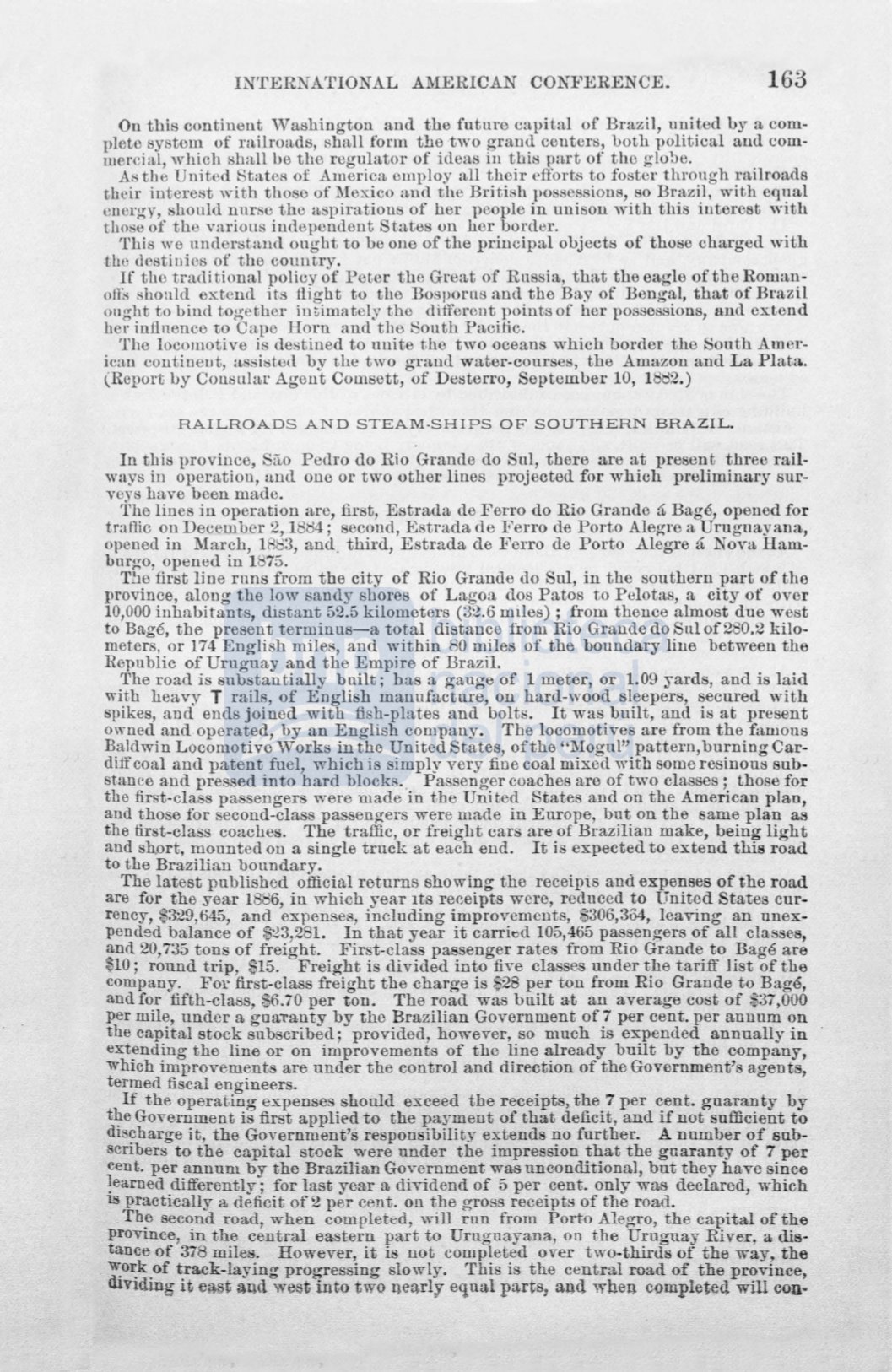

INTERNATIONAL AMERICAN CONFERENCE.
163
On this continent Washington and the future capital of Brazil, united by a com–
plete sy tem uf milroads, sball form the two granu ceutens, both política! and com–
mercial, which ¡,¡hall be the regulator of ideas in this p:ut of tho globe.
A· the United States of America omploy all their efforts to foster through railroads
tbeir iuterest with tho o of Mexico and tbe Britisb posses ious, so Brazil, with eqnal
cuorgv, hould nurse the aspirations of ber people in unisou with this iuterest with
those of the various iudepenuent States un hor border.
'l'bis we
under~;tancl
ongbt to be one of the principal objects of thoso chargod with
tbo destinies of t be country.
If
the traclitional policyof Peter the Great of H.ussia, that the eagle ofthe Roman–
oll's ·honld extend its flight to the Bosporu [tUd the Bay of Bengal, that of Brazil
ought to bind togethcr
i
u;:;ima tely the diíferont points of her pos ·essions, ancl extend
her inflnence
to
Capo Horn and tbe 'outh Pacitic.
'l'ho locomotive is destiued to unite the two oceans whicb border tbe Soutb Amer–
ican contioeut, assitlted by the two grand water-courses, the Amazon and La. Plata..
(Ueport by ConsulM' Agent Comsett, of De!:>terro, September 10, 18!:!2.)
RAILROADS AND STEAM-SHIPS OF SOUTHERN BRAZIL.
In this provioce, ao Peuro do Río Grande do Sul, tbere are at present tbree mil–
ways iu operation, and oue or t wo other lines projected for which preliminary sur–
veys bave been made.
The linea in operation are, fi1·st, Estrada ue Ferro do Río Grande
á
Bagé, opeued for
tratlic on Decewbor 2, 18t>4; second, Estrada d e Ferro de Porto Alegro a Uru<Yuayana,
opened in March, 1
'3, and_third, Estrada de F eiTo de Porto Alegre
á
Nova Ham–
bnr¡!o, opened in 1 75.
T3e first liue runs from tbe city of Río Grande do Sul, in tbe soutbern part of the
province, along the low saudy sbores of Lagoa. dos Patos to P elotas, a city of over
10,000 inhabitants, distant 52.5 kilometers (::$2.6 miles); from tbence almost due west
to Bagé, the present t erminus- a total distance from Río Grande do Snl of280.2 kilo–
meters, or 174 English mile ·, and within 80 miles of the boundary line between the
Hepublic ofUruguay and tbe Empire of Brazil.
The road is substantially built; ha-s a gauge of 1 meter, or 1.09 yards, and is laid
with heavy T raila, of Englisb manufacture, on hard-wood s1eepers, secured with
spikes, and ends joined with fish-plates and bolts.
It was built, and
i
ali present
owued and operated, by an English company. The locomotive are from tbe farnous
B_aldwin L ocomotive Work · in tbe United States, ofthe ''Mognl" pattern,buruing Car–
dtífcoal anu patent fnel, which is simply very fine coal mixed witb someresinous sub–
stance and pressed into bard block .
Pas enger coaches are of two classe ; those for
tbe first-class passengers were made in the United States and on the American plan,
and tho e for second-class passengers were made in Europe, but on the same plan as
the first-cla s coaches. The traffic, or freight cars are of Braziliao make, being light
aud sh.ort, mounted on a single truck at each end.
It
i expected to extend this road
to the Brazilian boundary.
The latest published official retums showing the receip1s and expenses of tbe road
are for the year 18 '6, in which year Its rec:eipts w ere, reduced to United States cur–
rency, $329,645, and expenses, including improvements,
306,304, leaving an unex–
pended balance of
S~3,2
l.
In that year it oarrit;d 105,465 pa sengers of all classes,
and 20,735 tons of freight. First-class passenger rates from Rio Grande to Bagé are
10; round trip, $15. Freight is divided into fi•e cla ses under the tari:ff list of the
company. Fol' first-cla-s freight the charge is 28 per ton from Rio Grande
to
Bagé,
andfor fiftb-cla s, $6.70 per ton. The road was built at an average cost of $37,000
per mile, under a gua-ranty by tbe Brazilian Government of7 per cent. per annum on
the capital stock subscribed; provicled, however, so much
is
expended annually in
ext~nd!-ng
the line or on improvements of the line already built by tbe company,
WhiCh 1mprovements are under the control and direction of the Government's agents,
termed fiscal engineers.
If
the operating expenses shonld exceed tbe receipts, the 7 per cent. guaranty by
t~eGo\erument
is first applied to the pa:rment ofthat deficit, and ünot snfficient to
d1s?harge it, the Government's responsibility extend no fnrther. A number of snb–
scnbers to tbe capital stock were under the impre
ion that the guaranty of 7 per
cent. per anuum by the Brazilian GoYernment was unconditiona], bnt they have ince
~earned
differently; for last year a dividend of 5 per cent. only was declarad, which
1
practically a deficit of2 per cent. on tbe gross receipts of the road.
Tb~ sec~nd
road, when complett:d,
will
rnn from Porto Alegro, tb e capital of the
provmce, In the central eastern part to Urngnayana, on the Uruguay River. a dis–
tanc
e of37' miles. However, it
is
not completed over two-thirds of the -way, tbe
wdio~
k.oft_rack-layina
pro~re
sing slowly. Tbis is the central road of the province,
n
dm
lt
e~t
a!l<l
we t
mto
two
ne~rly
equa.l p:uts,
and wben
®mpleted will
con-
















